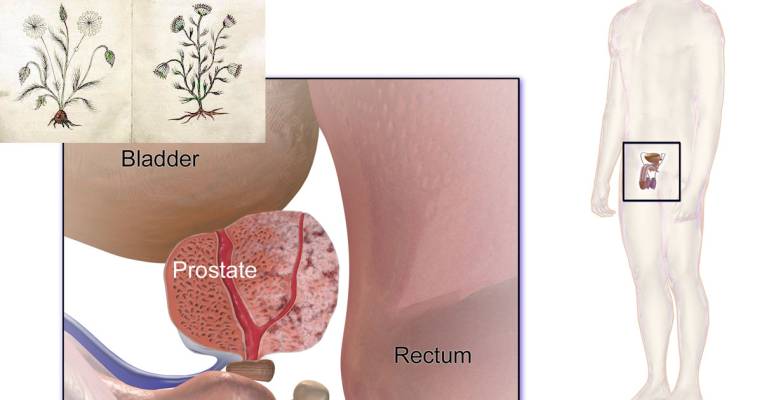 An enlarged prostate gland, benign prostatic hyperplasia (BPH), can interfere with urination, increasing the frequency and urge, or cause problems emptying the bladder. Surgery and drugs can be used to try to treat BPH. However, using herbal medicines to try to relieve BPH symptoms is common. Serenoa repens is a popular herbal medicine for BPH. A systemic review found that serenoa repens was well tolerated, providing mild to moderate improvement in urinary symptoms and flow measures. These improvements were comparable to those seen in men taking a prescription drug, finasteride, for BPH.
An enlarged prostate gland, benign prostatic hyperplasia (BPH), can interfere with urination, increasing the frequency and urge, or cause problems emptying the bladder. Surgery and drugs can be used to try to treat BPH. However, using herbal medicines to try to relieve BPH symptoms is common. Serenoa repens is a popular herbal medicine for BPH. A systemic review found that serenoa repens was well tolerated, providing mild to moderate improvement in urinary symptoms and flow measures. These improvements were comparable to those seen in men taking a prescription drug, finasteride, for BPH.
Traditional Use
Saw Palmetto has been used for at least 150 years in North America as a complete genito-urinary tonic for men as well as for some conditions in Women. Finley Ellingwood; M.D. wrote about these uses in his work called; The American Materia Medica, Therapeutics and Pharmacognosy in 1919. It was also given a nod in King?s American Dispensatory written by a Doctor (Harvey Wickes Felter) and a Pharmacist (John Uri Lloyd) in 1898. They mention its use for various respiratory ailments as well including laryngitis.Mechanism of Theraputic Action
Inhibition of the enzyme 5 alpha reductase, alpha 1 andrenergic receptor antagonism, anti-estrogenic activity in prostate tissue have all been suggested(2). It is interesting to note that the prostate and uterus are embryologically analogous tissue and that as men age testosterone levels drop and estrogen levels rise. Saw Palmetto Berries contain numerous lipids including; lauric, myristic and oleic acids, tri,di and monoglycerides, and phyto-sterols including large amounts of beta-sitosterol. It also contains Flavonoids, polysaccharides and an enzyme called lipase which splits the tri-glycerides into free fatty acids during the drying process and gives the berries their characteristic sharp odor(3). Although there have been many positive human clinical trials with this plant medicine further research is needed to fully understand the exact mechanism of its therapeutic activity.Literature
3139 men from 21 randomized trials lasting 4 to 48 weeks were assessed (1). 18 trials were double-blinded and treatment allocation concealment was adequate in 11 studies. Compared with placebo, Serenoa repens improved urinary symptom scores, symptoms, and flow measures. The weighted mean difference (WMD) for the urinary symptom score was -1.41 points (scale range 0-19), (95%CI = -2.52, -0.30, n = 1 study) and the risk ratio (RR) for self rated improvement was 1.76 (95%CI = 1.21, 2.54, n = 6 studies). The WMD for nocturia was -0.76 times per evening (95%CI = -1.22, -0.32; n = 10 studies). The WMD for peak urine flow was 1.86 ml/sec (95%CI = 0.60, 3.12, n = 9 studies). Compared with finasteride, Serenoa repens produced similar improvements in urinary symptom scores (WMD = 0.37 IPSS points (scale range 0-35), 95%CI = -0.45, 1.19, n = 2 studies) and peak urine flow (WMD = -0.74 ml/sec, 95%CI = -1.66, 0.18, n = 2 studies). Adverse effects due to Serenoa repens were mild and infrequent. Withdrawal rates in men assigned to placebo, Serenoa repens or finasteride were 7%, 9%, and 11%, respectively.References
(1)Wilt T, Ishani A, Mac Donald R.;"Serenoa repens for benign prostatic hyperplasia" , The Cochrane Database of Systematic Reviews 2006 Issue 2
(2)Carraro JC, et al. Prostate. 1996;29(4):231-40
(3)Niederprum HJ, et al. Testosterone 5-reductase inhibition by fatty acids from sabal serulata fruits. Phytomedicine. 1994;1: 127-133.




 Follow me on facebook
Follow me on facebook